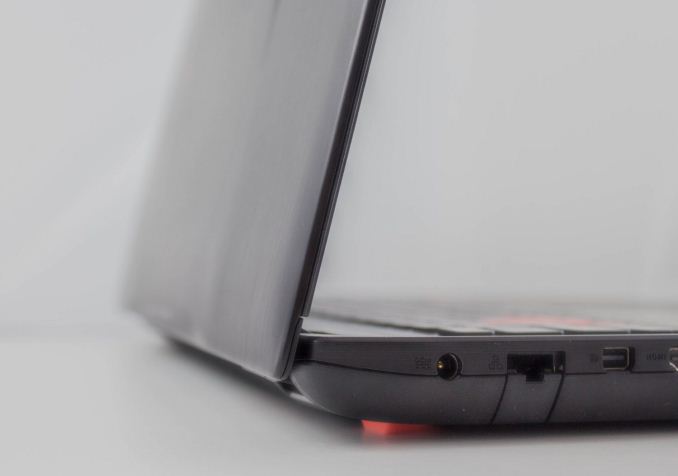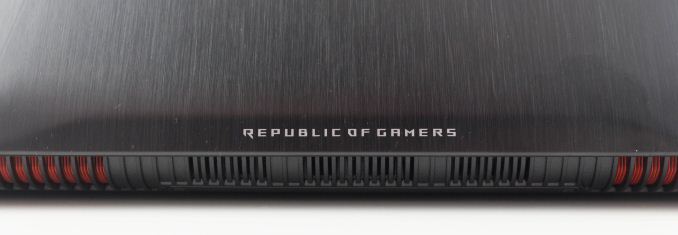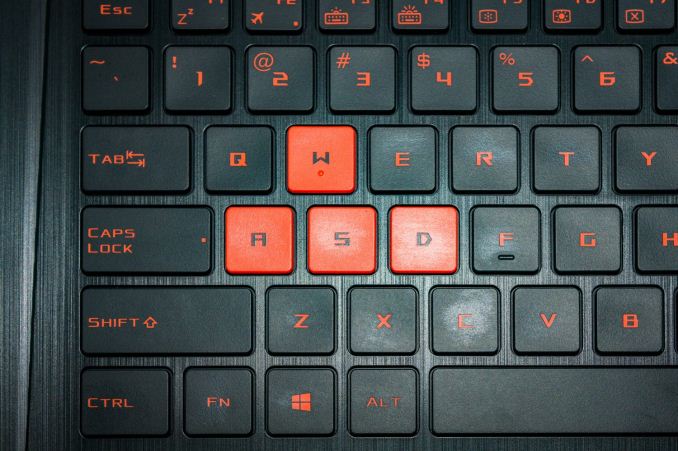The ASUS ROG Strix GL502VS Review: Mainstream GTX 1070 with G-SYNC
by Brett Howse on December 9, 2016 8:00 AM ESTFinal Words
ASUS has built a powerful gaming system, with all the latest technology inside. The Core i7-6700HQ is well known, and very capable. There will likely be a Kaby Lake update for quad-core processors soon, and we’ll see how they compare, but for now this is a capable CPU for a portable computer. The NVIDIA GTX 1070 is a very large step up from the GTX 970M, with performance that is right in-line with two GTX 980M cards in SLI. We’ve been waiting for FinFET for years on the GPU side, and it has paid off. In addition, it has up to 8 GB of GDDR5, and if you are interested in this notebook be very sure you are getting the 8 GB model since games like Rise of the Tomb Raider already use more the 4 GB on maximum settings.
As seems to be the case with ASUS, they also make sure the rest of the system is up to par as well. The single channel RAM is unfortunate, but also a bonus if you want to add another 16 GB yourself, since you’d only need to buy one more SO-DIMM. There is also USB 3.1 Gen 2, offering up to 10 Gbps of bandwidth, although it doesn’t support Thunderbolt 3. There are three USB 3 ports as well, meaning you have one foot in the present and one in the future. Gigabit Ethernet is pretty much expected on a gaming notebook, and it’s not missing either, but the Intel 8260 wireless adapter is one of the best we’ve ever used, offering great connection and transfer speeds, and a trouble-free experience. For those that need to connect to an external display, ASUS offers both HDMI and mini Display Port as well.
The included 62 Wh battery is pretty small for a system of this size, and that impacts the battery life quite a bit. The battery life on any gaming notebook is generally not very good though, and you pretty much need to use this on a desk plugged into a wall if you are going to use it for any length of time.
For a notebook of this size and power, the fact that ASUS got it under five pounds is a nice touch too. If you look around at the competition, something like the MSI GT62VR with GTX 1070 is about 6.5 pounds, and that is a big difference if you do need to travel with it.
The build quality is just average though, and the materials are decidedly low-end. There is nothing wrong with a plastic for a notebook body, but there are definitely different grades of plastic, and the one chosen for the GL502VS is very low quality. The keyboard is middle of the road, and while it is backlit, it only offers red backlighting when much of the competition offers choice here. The trackpad is not something I would want to use daily, so a mouse is almost a necessity. Some attention to detail here would go a long way, since this is the main part of the notebook experience. ASUS can do better, because they do offer better options on some of their other notebooks.
The cooling solution seems to get the job done, but once again ASUS has done better in other notebooks. The cooling vents blow directly onto the display when it is open, which causes the laptop to get quite warm, especially around the hinge where it is as high as 55°C. ASUS has a hinge-forward design on the G752 to avoid this exact issue, but it is not leveraged here. At the end of the day, it can keep the GTX 1070 cool enough to avoid throttling, but only just.
Despite the less than amazing chassis, the ASUS ROG Strix GL502VS does offer a competitive value for what is offered. The pricing is reasonable for a powerful gaming laptop, starting around $1275 for the GTX 1060 GL502VM with no SSD. The GTX 1070 GL502VS is closer to $1650 at the moment though, which starts to put it very close to some of the competition, or even above something like the MSI GT62VR depending on sales. Gigabyte also offers the P35Xv6 in this size, but for a bit more money. If you are in the market for a 15.6-inch gaming notebook, the space is very competitive. ASUS needs to address some of the build quality to really stand out in this space.















54 Comments
View All Comments
milkod2001 - Friday, December 9, 2016 - link
$1600 is not mainstream by all means but it has very decent specs that that price. It should last at least 3 years no probs. The only thing i would want to change is screen size, should have been 17''.Brett Howse - Sunday, December 11, 2016 - link
They do sell the GL702VM as a 17.3-inch model, but only with GTX 1060. ASUS has the GTX 1070 and up in the G752 which is a nice machine.BrokenCrayons - Friday, December 9, 2016 - link
Mainstream is different for everyone, but I agree that even on the low-end of its price spectrum that this laptop is absolutely not mainstream. However, I understand when you're a writer you're compelled to throw something out there that ultimately can end up the subject of unforseen debate. Let's try not to get overly hung up on it since, really, its as unimportant as calling a penguin a fish. The only thing that's changed is the label. Nothing fundamental about the squishy inside bits of the penguin are made different in doing so.SharpHawk - Friday, December 9, 2016 - link
No thermal data on the CPU?shelbystripes - Friday, December 9, 2016 - link
I got the GL502VM on sale from Amazon for a ridiculous $899 on Black Friday. At that price it's an utterly amazing system, and even at regular price is one of the cheapest Nvidia 10-series systems around, though I have some comments about its performance that this article fails to mention. The article makes it seem like it's just a GL502VS with a 1060 instead of a 1070, and that's not the case:1) The GL502VM doesn't come with G-Sync. At least, the lower end models don't.
2) The base model uses a quad-core i5, which is slightly slower, but more importantly lacks hyperthreading. I've found HT to historically not make a huge difference, but it's worth noting.
2) The GL502VM comes with 8GB RAM soldered on. It has one SODIMM slot, so if you buy a 16GB model it includes one 8GB DIMM plus the soldered-on RAM. Max memory capacity is limited to 24GB, since you can't swap out one channel of 8GB for 16GB later.
3) The GTX 1060 inside is the 3GB model, which actually has not just less RAM but fewer cores than the 6GB model. Still sufficient for 1080p gaming in a lot of games, especially for a budget gaming laptop, but worth noting it's about more than just the RAM. (I'm not sure if there's a similar discrepancy between the 4GB and 8GB GTX 1070 models available in the GL502VS, but at least you can get the higher end model there.)
4) This is really a comment on both machines, but the base models come with a mechanical HDD only. There's still an M.2 slot in the base models, it's just unpopulated. Still, I snagged a cheap 2.5" SATA SSD on Black Friday, and just a little simple surgery (not difficult, but 10 screws just to open it up, plus 8 screws for the HDD mount!) later, I had a MUCH faster system than I would have otherwise.
And lastly, a general tip when self-upgrading to save money: Windows 10 doesn't come with activation keys, it syncs your system unique ID to your Microsoft account. Microsoft made clean-installing Windows 10 much easier, you can download a tool from Microsoft's website to make a Windows 10 USB installer, but you'll need to boot the system at least once on the mechanical HDD to activate the copy of Windows 10 it comes with and link it to your Microsoft account. Then you can yank the HDD, swap in an SSD, and do a clean install (even if you're adding an M.2 SSD and keeping the HDD, you may want to do a clean install onto the SSD to get rid of the crapware anyway) without any problem. Just log into your Microsoft account during the reinstall and it'll recognize you have a Windows 10 license for that device. If (like me) you were clinging to Windows 7 on your last machine, I figure this knowledge might be new and useful to you.
sundragon - Friday, December 23, 2016 - link
Thank you! I may do this on my 502VS.label47 - Friday, December 9, 2016 - link
If you play heavy games the Battery will drain while plugged in...https://rog.asus.com/forum/showthread.php?88742-GL...
jsntech - Friday, December 9, 2016 - link
Yikes. Wonder what happens when it gets down to 0%? The ASUS rep responding to one of the bunches of people with the same complaint is unfortunate: " I've PM you a message, please check your inbox, thank you". Like they're trying to run interference instead of just openly acknowledging and working with customers. "Support" like that is one of the reasons I am hesitant to go with ASUS and others like them (though the bigger players are no better...sigh).kvnobrien - Friday, December 9, 2016 - link
"ASUS would have much better battery life if it just had a bigger battery" - quote of the year. Thank you this made me chuckle. I get the point you were trying to make it's just funny though.marco89nish - Friday, December 9, 2016 - link
I fail to see usefulness of G-Sync on 60Hz 1080p display with GTX 1070. It should be very challenging to drop 1070 to under 60 fps in next few years. Adding 75/90/120Hz display instead of G-Sync would yield much better value in my opinion.